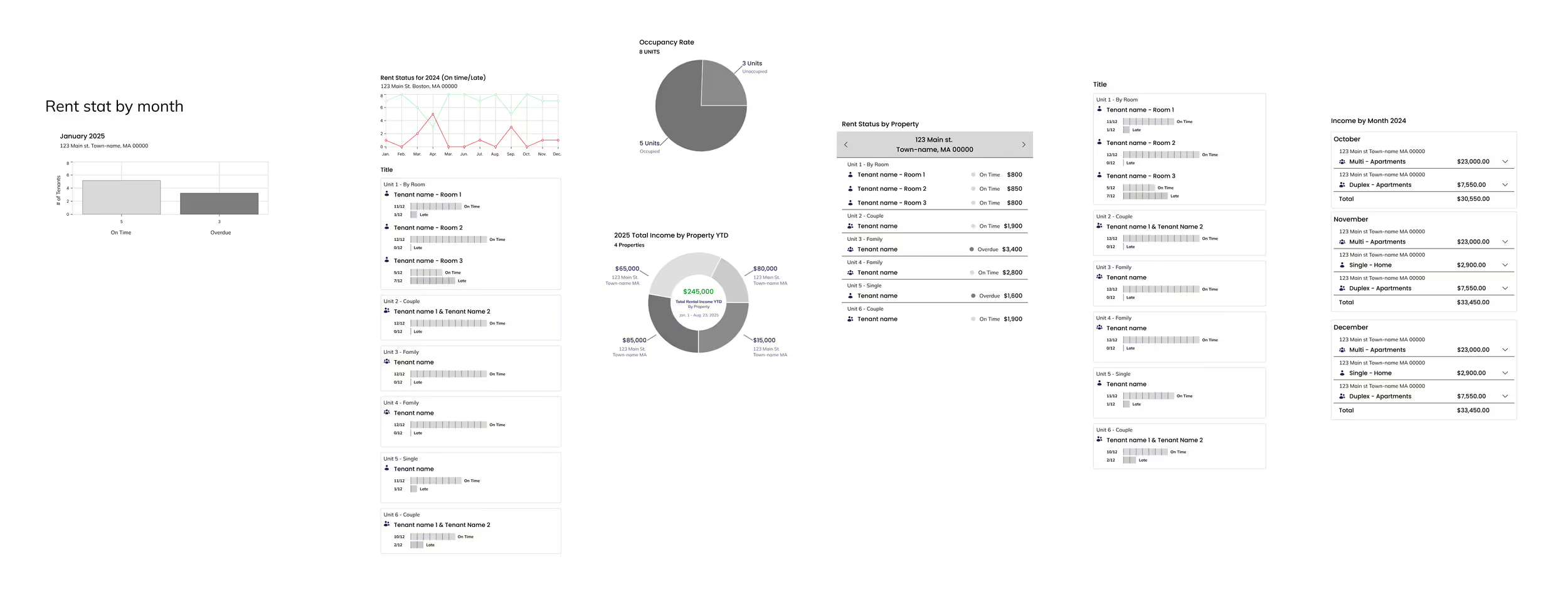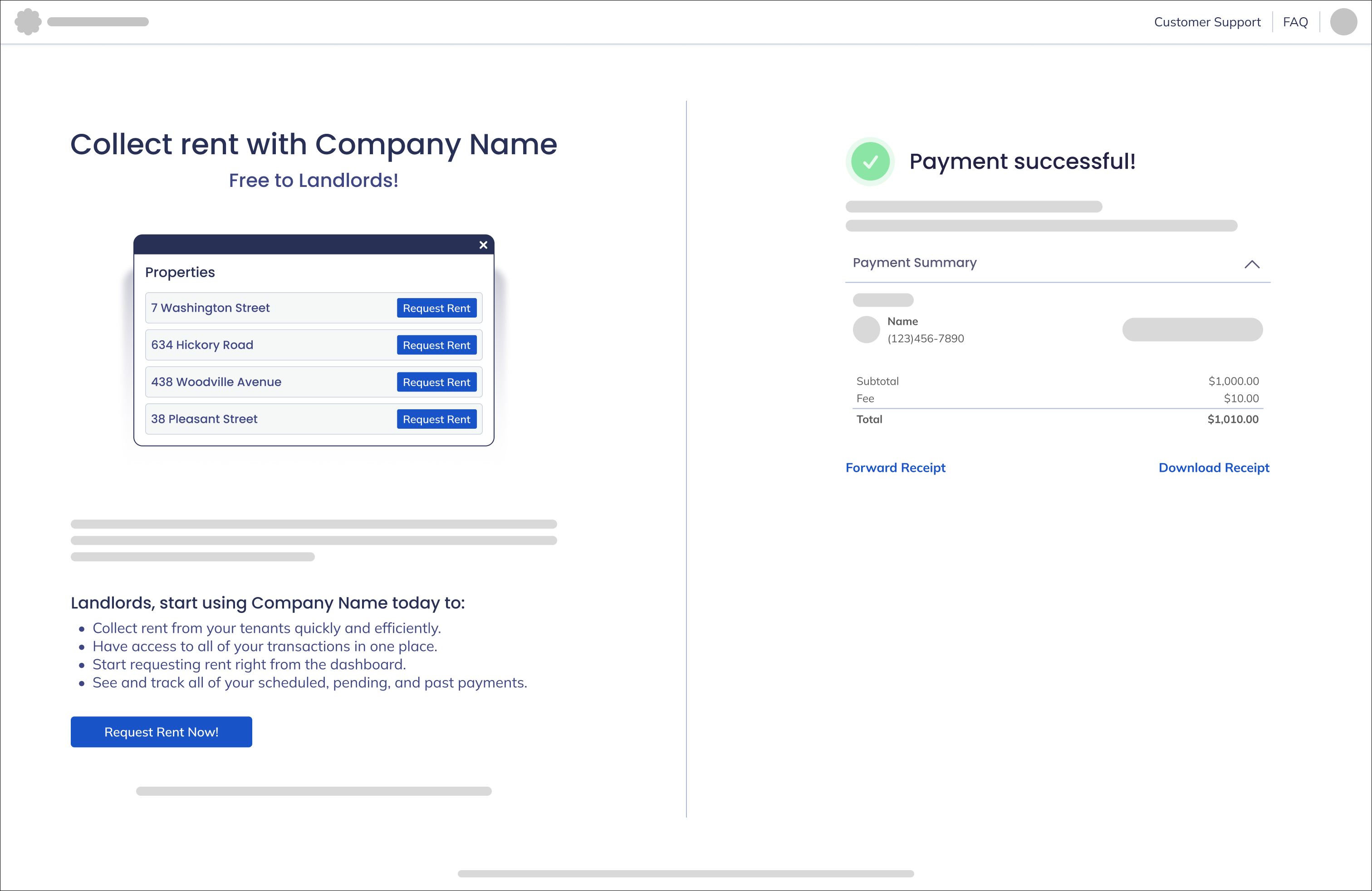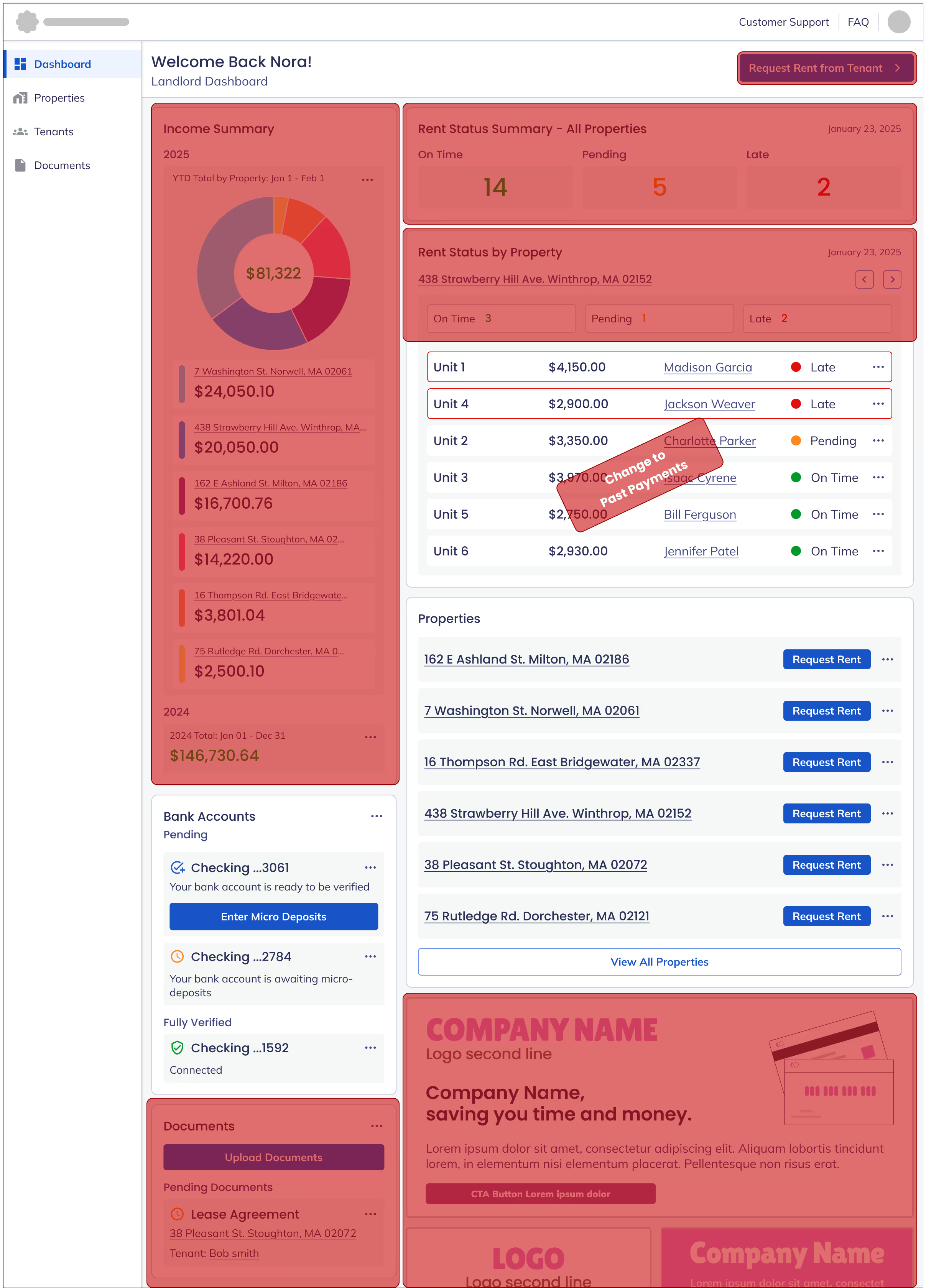.avif)
Real Estate Fintech Platform
Landlord Dashboard & Rent Request Flow
About this project
UI Designer
Summary, TL;DR
A fintech company in the real estate finance space is struggling with low user retention because it mainly supports one time transactions such as: earnest money deposits, commissions, refunds, closing funds, etc.
To solve this, we designed landlord and tenant dashboards, recurring rent payment and management flows, and various outreach methods encouraging landlords to collect monthly rent through the real estate fintech platform.
- This adds recurring tenant fees, which increases revenue and user numbers.
- The MVP focused on a quick launch by reusing existing design systems, and strategic planning.
Projected impacts
- Estimated user reactivation: Up to 2,000 landlords and 2,000 - 8,000 tenants. There is an estimated $10,000 - $40,000/month in new revenue.
- Projected revenue: Introducing a $5 tenant transaction fee could generate approximately $10,000 - $40,000 in new monthly revenue.
Business outcomes
- Increase in monthly active users and repeat transactions.
- A stronger case for investors by increasing user retention and generating consistent, recurring revenue.
Problem
This real estate fintech platform was designed for one-time real estate transactions like earnest money deposits and commissions. However, once these payments are complete, users don’t have a reason to return, resulting in:
- Low monthly active users and low user retention.
- Limited recurring revenue streams.
- Pressure from investors to show growth and higher engagement.
.avif)

A fulfilled order with over 20 small miscellaneous boxes.
They were using miscellaneous boxes for shipments and many of the shipments contained over 20 items per box, and that can be confusing without proper labeling. One quote the guide said stuck with me he said “sometimes we have customers loosing pieces of hardware because they can get separated from the other boxes and we have to ship them again.”
- A single order can contain 25 (or more) individual pieces.
- Some things such as the monitors, and registers are all sent in manufacturers boxes, no labels are on the outside of the box to identify it as a Toast product.
- Miscellaneous boxes are used when the toast boxes either don’t fit or are in low stock.
- Instructions / setup manuals are rare, only a few items have instructions.
Landlords’s needs
Rent collection & Tracking tenant’s payments.
- A streamlined way to collect and track recurring rent payments, including on-time and late payment statuses.
Improved efficiency.
- Management of all transactions, properties, and tenant information in one place.
Financial Reporting.
- View income trends by week, month, year, and by property.

The small boxes that could be used when parts aren’t pre-packaged in boxes from the manufacturer.
Company’s needs
Drive overall revenue growth.
- Get more users in the software making payments on a repeat, consistent basis.
Increase user traffic & retention.
- Expand the active user base by converting occasional users into consistent, repeat users.
Improve the software's appeal to investors.
- Create scalable growth, improve user metrics, and a stickier product experience, leading to increased revenue.
Solution
Add recurring payment functionality to the platform. Landlords can effortlessly request monthly rent from their tenants instead of relying solely on one time transactions. This approach not only creates a predictable, scalable revenue stream, it also drives user retention and increases profitability through a small tenant-paid fee on each rent payment.

A fulfilled order with over 20 small miscellaneous boxes.
They were using miscellaneous boxes for shipments and many of the shipments contained over 20 items per box, and that can be confusing without proper labeling. One quote the guide said stuck with me he said “sometimes we have customers loosing pieces of hardware because they can get separated from the other boxes and we have to ship them again.”
- A single order can contain 25 (or more) individual pieces.
- Some things such as the monitors, and registers are all sent in manufacturers boxes, no labels are on the outside of the box to identify it as a Toast product.
- Miscellaneous boxes are used when the toast boxes either don’t fit or are in low stock.
- Instructions / setup manuals are rare, only a few items have instructions.
To successfully deliver this solution, our key initiatives include:
Landlord outreach, in platform & email
- Develop targeted outreach and in software messaging to drive awareness and adoption of new rental payment management features.
A Landlord dashboard
- Design a streamlined dashboard that incentivizes landlords to engage regularly with the platform, Increasing user traffic & retention.
Landlord rent request flows
- Activate the existing large network of agents and landlords by integrating rent request workflows that encourage repeat usage.
Tenant rent payment flows, with a small fee
- Establish a low fee structure for tenants that balances affordability with business revenue goals.
A tenant dashboard
- Design a clear, intuitive dashboard for tenants to pay and manage rent payments, reducing friction and increasing consistent platform engagement.
Challenges Faced
Driving landlord adoption in a competitive market.
- Solution: Remove any financial barriers for landlords by offering recurring payment features free of charge.
Meeting a tight deadline for a phase 1 MVP release.
- Solution: Reduce & reuse! Align stakeholder expectations by limiting scope, strategic planning, and reusing existing design systems
The tenant fee.
- Solution: The fee must be set low enough to feel minimal to tenants. Finding the right balance is critical to the project’s overall success.

The small boxes that could be used when parts aren’t pre-packaged in boxes from the manufacturer.
Ideation

Landlord User Flow

Landlord Dashboard Ideas & Mockups
Landlord Outreach
To support rollout and user activation among landlords, we included contextual in product messaging on the success page after completing a transaction, using existing payment type metadata to ensure promotions were surfaced only to landlords. In parallel, we explored targeted email campaigns to raise awareness and drive adoption of the new features.

Landlord Dashboard
This is a detailed version of the dashboard we’d like to build towards over time. We envisioned a comprehensive dashboard enabling landlords to manage rent requests, track payments, and oversee property and income insights.
.avif)
Scoping for MVP
To meet the end of Q1 launch deadline we prioritized a lean, core feature version of the dashboard. Prioritizing core features delivers essential value to users quickly, enables earlier revenue generation, and supports rapid iteration based on real user feedback, while also ensuring efficient use of resources.

.avif)
Landlord Rent Request Flow
Once landlords send a rent request through the real estate fintech platform, tenants receive an email prompting them to complete their rental payment, linking landlord recurring payment workflows with their tenants. This drove a higher user retention, recurring revenue, and investor confidence through increased engagement.
All tenant-facing experiences and design work in this project were handled by Jes Chuhta.
Results & Impacts
Projected impacts
- Estimated user reactivation: Up to 2,000 landlords and 2,000 - 8,000 tenants. There is an estimated $10,000 - $40,000/month in new revenue.
- Projected revenue: Introducing a $5 tenant transaction fee could generate approximately $10,000 - $40,000 in new monthly recurring revenue.
Business outcomes
- Increase in monthly active users and repeat transactions.
- A stronger case for investors by increasing user retention and generating consistent, recurring revenue.
Going Forward
What I’d focus on to scale these features and reach product market fit.
Work toward product market fit & create an "All in one" solution
Expanding functionality is crucial to remain competitive. Many of the real estate fintech platform's competitors are offering more robust platforms with a wider variety of features.
Consider adding property management features
- Maintenance tracking, automated lease renewals, and document storage. This will make the real estate fintech platform a more comprehensive, all in one solution for landlords.
Build out a stronger dashboard and add other reporting tools for landlords
- They can quickly assess their property's performance.
- Validate existing features and future directions by conducting user interviews, surveys, and digging into analytics to identify pain points and prioritize any high impact improvements.
Provide landlords with data & analytics
Highlight key metrics to support better decision making.
Provide landlords with clear, actionable visual insights on their property's performance
- Highlight like payment history, Income, late payment patterns, occupancy trends, and other key metrics.
- This will encourage them to rely on the real estate fintech platform as their primary management tool instead of manual spreadsheets or third-party services.
Explore integrations with third-party services
- Examples: QuickBooks for accounting services or TransUnion for credit checks to increase stickiness and reduce churn.
Build out onboarding systems for new landlords and tenants:
Smooth, intuitive, and scalable onboarding workflows directly impact adoption, helps users realize value faster, and reduces customer support demands.
Tailor onboarding for different user types
- Small individual landlords, large property managers, and tenants all have different onboarding needs.
Provide more intuitive onboarding flows
- Tooltips, hints, and self-service resources added to the onboarding flows reduces customer support requests.
Enhance mobile payment and management flows
A strong mobile experience is a competitive differentiator, younger renters expect mobile first solutions. It also ensures consistent engagement with the platform.
Iterate on layout and messaging
- Validate existing flows by conducting user interviews, surveys, and digging into analytics.
- Optimizing layout and massaging ensures the user's ease in navigation, the clarity of given information, and helps with mobile accessibility.
Encourage a marketing push to drive adoption and engagement
Partner with marketing to launch targeted campaigns highlighting the benefits of the new landlord dashboard and rent collection flows with the real estate fintech platform for both existing and potential customers.
Utilize different outreach methods
- Email campaigns, in-app notifications, webinars, social media posts, and possibly short video demos to ensure the message reaches customers at multiple touch points.
Feature messaging
- Emphasize time saving features, improved tenant communication, and simplified rent collection workflows
- Tailor messaging for different landlord groups: Small independent landlords or large property managers, they have unique needs.
- Share success stories and testimonials from existing users to encourage adoption among hesitant landlords.